List of fusion experiments
Experiments directed toward developing fusion power are invariably done with dedicated machines which can be classified according to the principles they use to confine the plasma fuel and keep it hot.
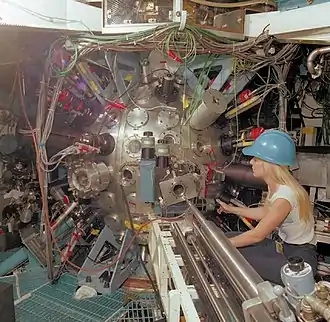
.jpg.webp)
The major division is between magnetic confinement and inertial confinement. In magnetic confinement, the tendency of the hot plasma to expand is counteracted by the Lorentz force between currents in the plasma and magnetic fields produced by external coils. The particle densities tend to be in the range of 1018 to 1022 m−3 and the linear dimensions in the range of 0.1 to 10 m. The particle and energy confinement times may range from under a millisecond to over a second, but the configuration itself is often maintained through input of particles, energy, and current for times that are hundreds or thousands of times longer. Some concepts are capable of maintaining a plasma indefinitely.
In contrast, with inertial confinement, there is nothing to counteract the expansion of the plasma. The confinement time is simply the time it takes the plasma pressure to overcome the inertia of the particles, hence the name. The densities tend to be in the range of 1031 to 1033 m−3 and the plasma radius in the range of 1 to 100 micrometers. These conditions are obtained by irradiating a millimeter-sized solid pellet with a nanosecond laser or ion pulse. The outer layer of the pellet is ablated, providing a reaction force that compresses the central 10% of the fuel by a factor of 10 or 20 to 103 or 104 times solid density. These microplasmas disperse in a time measured in nanoseconds. For a fusion power reactor, a repetition rate of several per second will be needed.
Magnetic confinement
Within the field of magnetic confinement experiments, there is a basic division between toroidal and open magnetic field topologies. Generally speaking, it is easier to contain a plasma in the direction perpendicular to the field than parallel to it. Parallel confinement can be solved either by bending the field lines back on themselves into circles or, more commonly, toroidal surfaces, or by constricting the bundle of field lines at both ends, which causes some of the particles to be reflected by the mirror effect. The toroidal geometries can be further subdivided according to whether the machine itself has a toroidal geometry, i.e., a solid core through the center of the plasma. The alternative is to dispense with a solid core and rely on currents in the plasma to produce the toroidal field.
Mirror machines have advantages in a simpler geometry and a better potential for direct conversion of particle energy to electricity. They generally require higher magnetic fields than toroidal machines, but the biggest problem has turned out to be confinement. For good confinement there must be more particles moving perpendicular to the field than there are moving parallel to the field. Such a non-Maxwellian velocity distribution is, however, very difficult to maintain and energetically costly.
The mirrors' advantage of simple machine geometry is maintained in machines which produce compact toroids, but there are potential disadvantages for stability in not having a central conductor and there is generally less possibility to control (and thereby optimize) the magnetic geometry. Compact toroid concepts are generally less well developed than those of toroidal machines. While this does not necessarily mean that they cannot work better than mainstream concepts, the uncertainty involved is much greater.
Somewhat in a class by itself is the Z-pinch, which has circular field lines. This was one of the first concepts tried, but it did not prove very successful. Furthermore, there was never a convincing concept for turning the pulsed machine requiring electrodes into a practical reactor.
The dense plasma focus is a controversial and "non-mainstream" device that relies on currents in the plasma to produce a toroid. It is a pulsed device that depends on a plasma that is not in equilibrium and has the potential for direct conversion of particle energy to electricity. Experiments are ongoing to test relatively new theories to determine if the device has a future.
Toroidal machine
Toroidal machines can be axially symmetric, like the tokamak and the reversed field pinch (RFP), or asymmetric, like the stellarator. The additional degree of freedom gained by giving up toroidal symmetry might ultimately be usable to produce better confinement, but the cost is complexity in the engineering, the theory, and the experimental diagnostics. Stellarators typically have a periodicity, e.g. a fivefold rotational symmetry. The RFP, despite some theoretical advantages such as a low magnetic field at the coils, has not proven very successful.
Tokamak
| Device Name | Status | Construction | Operation | Location | Organisation | Major/Minor Radius | B-field | Plasma current | Purpose | Image |
|---|---|---|---|---|---|---|---|---|---|---|
| T-1 | Shut down | ? | 1957-1959 | Moscow | Kurchatov Institute | 0.625 m/0.13 m | 1 T | 0.04 MA | First tokamak | 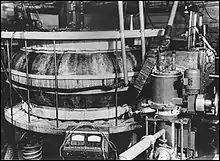 |
| T-3 | Shut down | ? | 1962-? | Moscow | Kurchatov Institute | 1 m/0.12 m | 2.5 T | 0.06 MA | ||
| ST (Symmetric Tokamak) | Shut down | Model C | 1970-1974 | Princeton | Princeton Plasma Physics Laboratory | 1.09 m/0.13 m | 5.0 T | 0.13 MA | First American tokamak, converted from Model C stellarator | |
| ORMAK (Oak Ridge tokaMAK) | Shut down | 1971-1976 | Oak Ridge | Oak Ridge National Laboratory | 0.8 m/0.23 m | 2.5 T | 0.34 MA | First to achieve 20 MK plasma temperature | .jpg.webp) | |
| ATC (Adiabatic Toroidal Compressor) | Shut down | 1971-1972 | 1972-1976 | Princeton | Princeton Plasma Physics Laboratory | 0.88 m/0.11 m | 2 T | 0.05 MA | Demonstrate compressional plasma heating | .jpg.webp) |
| TFR (Tokamak de Fontenay-aux-Roses) | Shut down | 1973-1984 | Fontenay-aux-Roses | CEA | 1 m/0.2 m | 6 T | 0.49 | |||
| T-10 (Tokamak-10) | Operational | 1975- | Moscow | Kurchatov Institute | 1.50 m/0.37 m | 4 T | 0.8 MA | Largest tokamak of its time | .jpg.webp) | |
| PLT (Princeton Large Torus) | Shut down | 1975-1986 | Princeton | Princeton Plasma Physics Laboratory | 1.32 m/0.4 m | 4 T | 0.7 MA | First to achieve 1 MA plasma current | .jpg.webp) | |
| ISX-B | Shut down | ? | 1978-? | Oak Ridge | Oak Ridge National Laboratory | 0.93 m/0.27 m | 1.8 T | 0.2 MA | Superconducting coils, attempt high-beta operation | |
| ASDEX (Axially Symmetric Divertor Experiment)[2] | Recycled →HL-2A | 1980-1990 | Garching | Max-Planck-Institut für Plasmaphysik | 1.65 m/0.4 m | 2.8 T | 0.5 MA | Discovery of the H-mode in 1982 | ||
| TEXTOR (Tokamak Experiment for Technology Oriented Research)[3][4] | Shut down | 1976-1980 | 1981-2013 | Jülich | Forschungszentrum Jülich | 1.75 m/0.47 m | 2.8 T | 0.8 MA | Study plasma-wall interactions | |
| TFTR (Tokamak Fusion Test Reactor)[5] | Shut down | 1980-1982 | 1982-1997 | Princeton | Princeton Plasma Physics Laboratory | 2.4 m/0.8 m | 6 T | 3 MA | Attempted scientific break-even, reached record fusion power of 10.7 MW and temperature of 510 MK | .jpg.webp) |
| JET (Joint European Torus)[6] | Operational | 1978-1983 | 1983- | Culham | Culham Centre for Fusion Energy | 2.96 m/0.96 m | 4 T | 7 MA | Record for fusion output power 16.1 MW | 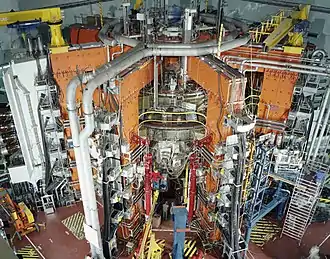 |
| Novillo[7][8] | Shut down | NOVA-II | 1983-2004 | Mexico City | Instituto Nacional de Investigaciones Nucleares | 0.23 m/0.06 m | 1 T | 0.01 MA | Study plasma-wall interactions | |
| JT-60 (Japan Torus-60)[9] | Recycled →JT-60SA | 1985-2010 | Naka | Japan Atomic Energy Research Institute | 3.4 m/1.0 m | 4 T | 3 MA | High-beta steady-state operation, highest fusion triple product | ||
| DIII-D[10] | Operational | 1986[11] | 1986- | San Diego | General Atomics | 1.67 m/0.67 m | 2.2 T | 3 MA | Tokamak Optimization |  |
| STOR-M (Saskatchewan Torus-Modified)[12] | Operational | 1987- | Saskatoon | Plasma Physics Laboratory (Saskatchewan) | 0.46 m/0.125 m | 1 T | 0.06 MA | Study plasma heating and anomalous transport | ||
| T-15 | Recycled →T-15MD | 1983-1988 | 1988-1995 | Moscow | Kurchatov Institute | 2.43 m/0.7 m | 3.6 T | 1 MA | First superconducting tokamak | 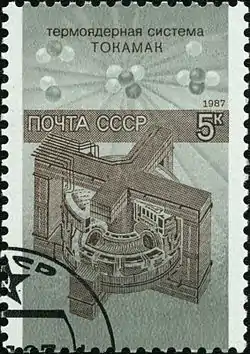 |
| Tore Supra[13] | Recycled →WEST | 1988-2011 | Cadarache | Département de Recherches sur la Fusion Contrôlée | 2.25 m/0.7 m | 4.5 T | 2 MA | Large superconducting tokamak with active cooling | ||
| ADITYA (tokamak) | Operational | 1989- | Gandhinagar | Institute for Plasma Research | 0.75 m/0.25 m | 1.2 T | 0.25 MA | |||
| COMPASS (COMPact ASSembly)[14][15] | Operational | 1980- | 1989- | Prague | Institute of Plasma Physics AS CR | 0.56 m/0.23 m | 2.1 T | 0.32 MA |  | |
| FTU (Frascati Tokamak Upgrade) | Operational | 1990- | Frascati | ENEA | 0.935 m/0.35 m | 8 T | 1.6 MA | |||
| START (Small Tight Aspect Ratio Tokamak)[16] | Shut down | 1990-1998 | Culham | Culham Centre for Fusion Energy | 0.3 m/? | 0.5 T | 0.31 MA | First full-sized Spherical Tokamak | ||
| ASDEX Upgrade (Axially Symmetric Divertor Experiment) | Operational | 1991- | Garching | Max-Planck-Institut für Plasmaphysik | 1.65 m/0.5 m | 2.6 T | 1.4 MA | 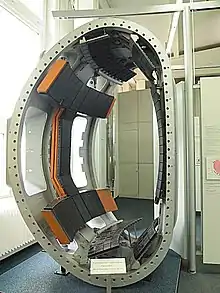 | ||
| Alcator C-Mod (Alto Campo Toro)[17] | Operational (Funded by Fusion Startups) | 1986- | 1991-2016 | Cambridge | Massachusetts Institute of Technology | 0.68 m/0.22 m | 8 T | 2 MA | Record plasma pressure 2.05 bar | 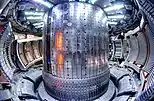 |
| ISTTOK (Instituto Superior Técnico TOKamak)[18] | Operational | 1992- | Lisbon | Instituto de Plasmas e Fusão Nuclear | 0.46 m/0.085 m | 2.8 T | 0.01 MA | |||
| TCV (Tokamak à Configuration Variable)[19] | Operational | 1992- | Lausanne | École Polytechnique Fédérale de Lausanne | 0.88 m/0.25 m | 1.43 T | 1.2 MA | Confinement studies | 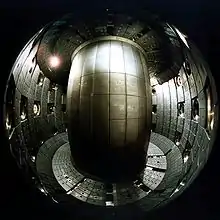 | |
| HBT-EP (High Beta Tokamak-Extended Pulse) | Operational | 1993- | New York City | Columbia University Plasma Physics Laboratory | 0.92 m/0.15 m | 0.35 T | 0.03 MA | High-Beta tokamak |  | |
| HT-7 (Hefei Tokamak-7) | Shut down | 1991-1994 | 1995-2013 | Hefei | Hefei Institutes of Physical Science | 1.22 m/0.27 m | 2 T | 0.2 MA | China's first superconducting tokamak | 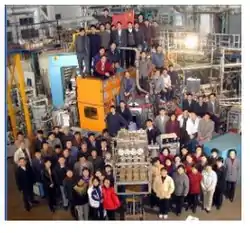 |
| Pegasus Toroidal Experiment[20] | Operational | ? | 1996- | Madison | University of Wisconsin–Madison | 0.45 m/0.4 m | 0.18 T | 0.3 MA | Extremely low aspect ratio | .jpg.webp) |
| NSTX (National Spherical Torus Experiment)[21] | Operational | 1999- | Plainsboro Township | Princeton Plasma Physics Laboratory | 0.85 m/0.68 m | 0.3 T | 2 MA | Study the spherical tokamak concept | .jpg.webp) | |
| ET (Electric Tokamak) | Recycled →ETPD | 1998 | 1999-2006 | Los Angeles | UCLA | 5 m/1 m | 0.25 T | 0.045 MA | Largest tokamak of its time | 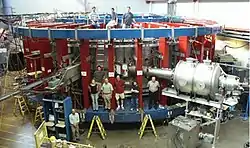 |
| CDX-U (Current Drive Experiment-Upgrade) | Recycled →LTX | 2000-2005 | Princeton | Princeton Plasma Physics Laboratory | 0.3 m/? m | 0.23 T | 0.03 MA | Study Lithium in plasma walls | .jpg.webp) | |
| MAST (Mega-Ampere Spherical Tokamak)[22] | Recycled →MAST-Upgrade | 1997-1999 | 2000-2013 | Culham | Culham Centre for Fusion Energy | 0.85 m/0.65 m | 0.55 T | 1.35 MA | Investigate spherical tokamak for fusion |  |
| HL-2A | Recycled →HL-2M | 2000-2002 | 2002-2018 | Chengdu | Southwestern Institute of Physics | 1.65 m/0.4 m | 2.7 T | 0.43 MA | H-mode physics, ELM mitigation | |
| SST-1 (Steady State Superconducting Tokamak)[23] | Operational | 2001- | 2005- | Gandhinagar | Institute for Plasma Research | 1.1 m/0.2 m | 3 T | 0.22 MA | Produce a 1000 s elongated double null divertor plasma | |
| EAST (Experimental Advanced Superconducting Tokamak)[24] | Operational | 2000-2005 | 2006- | Hefei | Hefei Institutes of Physical Science | 1.85 m/0.43 m | 3.5 T | 0.5 MA | H-Mode plasma for over 100 s at 50 MK | 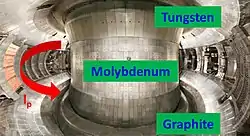 |
| J-TEXT (Joint TEXT) | Operational | TEXT (Texas EXperimental Tokamak) | 2007- | Wuhan | Huazhong University of Science and Technology | 1.05 m/0.26 m | 2.0 T | 0.2 MA | Develop plasma control | |
| KSTAR (Korea Superconducting Tokamak Advanced Research)[25] | Operational | 1998-2007 | 2008- | Daejeon | National Fusion Research Institute | 1.8 m/0.5 m | 3.5 T | 2 MA | Tokamak with fully superconducting magnets, 20 s-long operation at 100 MK[26] | 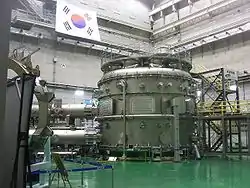 |
| LTX (Lithium Tokamak Experiment) | Operational | 2005-2008 | 2008- | Princeton | Princeton Plasma Physics Laboratory | 0.4 m/? m | 0.4 T | 0.4 MA | Study Lithium in plasma walls | .jpg.webp) |
| QUEST (Q-shu University Experiment with Steady-State Spherical Tokamak)[27] | Operational | 2008- | Kasuga | Kyushu University | 0.68 m/0.4 m | 0.25 T | 0.02 MA | Study steady state operation of a Spherical Tokamak | .jpg.webp) | |
| Kazakhstan Tokamak for Material testing (KTM) | Operational | 2000-2010 | 2010- | Kurchatov | National Nuclear Center of the Republic of Kazakhstan | 0.86 m/0.43 m | 1 T | 0.75 MA | Testing of wall and divertor | |
| ST25-HTS[28] | Operational | 2012-2015 | 2015- | Culham | Tokamak Energy Ltd | 0.25 m/0.125 m | 0.1 T | 0.02 MA | Steady state plasma | 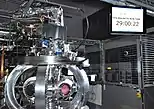 |
| WEST (Tungsten Environment in Steady-state Tokamak) | Operational | 2013-2016 | 2016- | Cadarache | Département de Recherches sur la Fusion Contrôlée | 2.5 m/0.5 m | 3.7 T | 1 MA | Superconducting tokamak with active cooling | 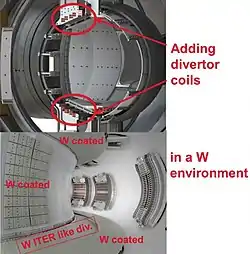 |
| ST40[29] | Operational | 2017-2018 | 2018- | Didcot | Tokamak Energy Ltd | 0.4 m/0.3 m | 3 T | 2 MA | First high field spherical tokamak | 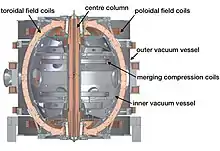 |
| MAST-U (Mega-Ampere Spherical Tokamak Upgrade)[30] | Operational | 2013-2019 | 2020- | Culham | Culham Centre for Fusion Energy | 0.85 m/0.65 m | 0.92 T | 2 MA | Test new exhaust concepts for a spherical tokamak | |
| HL-2M[31] | Operational | 2018-2019 | 2020- | Leshan | Southwestern Institute of Physics | 1.78 m/0.65 m | 2.2 T | 1.2 MA | Elongated plasma with 200 MK | 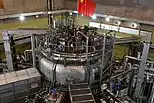 |
| JT-60SA (Japan Torus-60 super, advanced)[32] | Under construction | 2013-2020 | 2020? | Naka | Japan Atomic Energy Research Institute | 2.96 m/1.18 m | 2.25 T | 5.5 MA | Optimise plasma configurations for ITER and DEMO with full non-inductive steady-state operation | .jpg.webp) |
| T-15MD | Under construction | 2010-2020 | 2021- | Moscow | Kurchatov Institute | 1.48 m/0.67 m | 2 T | 2 MA | Hybrid fusion/fission reactor | 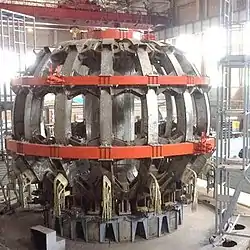 |
| ITER[33] | Under construction | 2013-2025? | 2025? | Cadarache | ITER Council | 6.2 m/2.0 m | 5.3 T | 15 MA ? | Demonstrate feasibility of fusion on a power-plant scale with 500 MW fusion power | _(12219071813)_(cropped).jpg.webp) |
| DTT (Divertor Tokamak Test facility)[34][35] | Planned | 2022-2025? | 2025? | Frascati | ENEA | 2.14 m/0.70 m | 6 T ? | 5.5 MA ? | Superconducting tokamak to study power exhaust | |
| SPARC[36][37] | Planned | 2021-? | 2025? | Commonwealth Fusion Systems and MIT Plasma Science and Fusion Center | 1.85 m/0.57 m | 12.2 T | 8.7 MA | Compact, high-field tokamak with ReBCO coils and 100 MW planned fusion power | 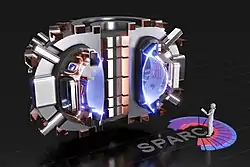 | |
| IGNITOR[38] | Planned[39] | ? | >2024 | Troitzk | ENEA | 1.32 m/0.47 m | 13 T | 11 MA ? | Compact fusion reactor with self-sustained plasma and 100 MW of planned fusion power | |
| CFETR (China Fusion Engineering Test Reactor)[40] | Planned | 2020? | 2030? | Institute of Plasma Physics, Chinese Academy of Sciences | 5.7 m/1.6 m ? | 5 T ? | 10 MA ? | Bridge gaps between ITER and DEMO, planned fusion power 1000 MW | ||
| STEP (Spherical Tokamak for Energy Production) | Planned | 2032? | 2040? | Culham | Culham Centre for Fusion Energy | 3 m/2 m ? | ? | ? | Spherical tokamak with hundreds of MW planned electrical output | |
| K-DEMO (Korean fusion demonstration tokamak reactor)[41] | Planned | 2037? | National Fusion Research Institute | 6.8 m/2.1 m | 7 T | 12 MA ? | Prototype for the development of commercial fusion reactors with around 2200 MW of fusion power | 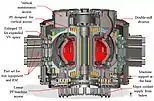 | ||
| DEMO (DEMOnstration Power Station) | Planned | 2031? | 2044? | ? | 9 m/3 m ? | 6 T ? | 20 MA ? | Prototype for a commercial fusion reactor | 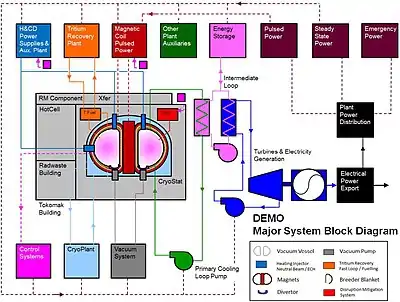 |
Stellarator
| Device Name | Status | Construction | Operation | Type | Location | Organisation | Major/Minor Radius | B-field | Purpose | Image |
|---|---|---|---|---|---|---|---|---|---|---|
| Model A | Shut down | 1952-1953 | 1953-? | Figure-8 | Princeton | Princeton Plasma Physics Laboratory | 0.3 m/0.02 m | 0.1 T | First stellarator | |
| Model B | Shut down | 1953-1954 | 1954-1959 | Figure-8 | Princeton | Princeton Plasma Physics Laboratory | 0.3 m/0.02 m | 5 T | Development of plasma diagnostics | |
| Model B-1 | Shut down | ?-1959 | Figure-8 | Princeton | Princeton Plasma Physics Laboratory | 0.25 m/0.02 m | 5 T | Yielded 1 MK plasma temperatures | ||
| Model B-2 | Shut down | 1957 | Figure-8 | Princeton | Princeton Plasma Physics Laboratory | 0.3 m/0.02 m | 5 T | Electron temperatures up to 10 MK | ||
| Model B-3 | Shut down | 1957 | 1958- | Figure-8 | Princeton | Princeton Plasma Physics Laboratory | 0.4 m/0.02 m | 4 T | Last figure-8 device, confinement studies of ohmically heated plasma | |
| Model B-64 | Shut down | 1955 | 1955 | Square | Princeton | Princeton Plasma Physics Laboratory | ? m/0.05 m | 1.8 T | ||
| Model B-65 | Shut down | 1957 | 1957 | Racetrack | Princeton | Princeton Plasma Physics Laboratory | ||||
| Model B-66 | Shut down | 1958 | 1958-? | Racetrack | Princeton | Princeton Plasma Physics Laboratory | ||||
| Wendelstein 1-A | Shut down | 1960 | Racetrack | Garching | Max-Planck-Institut für Plasmaphysik | 0.35 m/0.02 m | 2 T | ℓ=3 | ||
| Wendelstein 1-B | Shut down | 1960 | Racetrack | Garching | Max-Planck-Institut für Plasmaphysik | 0.35 m/0.02 m | 2 T | ℓ=2 | ||
| Model C | Recycled →ST | 1957-1962 | 1962-1969 | Racetrack | Princeton | Princeton Plasma Physics Laboratory | 1.9 m/0.07 m | 3.5 T | Found large plasma losses by Bohm diffusion | |
| L-1 | Shut down | 1963 | 1963-1971 | Lebedev | Lebedev Physical Institute | 0.6 m/0.05 m | 1 T | |||
| SIRIUS | Shut down | 1964-? | Kharkov | |||||||
| TOR-1 | Shut down | 1967 | 1967-1973 | Lebedev | Lebedev Physical Institute | 0.6 m/0.05 m | 1 T | |||
| TOR-2 | Shut down | ? | 1967-1973 | Lebedev | Lebedev Physical Institute | 0.63 m/0.036 m | 2.5 T | |||
| Wendelstein 2-A | Shut down | 1965-1968 | 1968-1974 | Heliotron | Garching | Max-Planck-Institut für Plasmaphysik | 0.5 m/0.05 m | 0.6 T | Good plasma confinement “Munich mystery” | 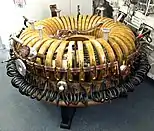 |
| Wendelstein 2-B | Shut down | ?-1970 | 1971-? | Heliotron | Garching | Max-Planck-Institut für Plasmaphysik | 0.5 m/0.055 m | 1.25 T | Demonstrated similar performance as tokamaks |  |
| L-2 | Shut down | ? | 1975-? | Lebedev | Lebedev Physical Institute | 1 m/0.11 m | 2.0 T | |||
| WEGA | Recycled →HIDRA | 1972-1975 | 1975-2013 | Classical stellarator | Greifswald | Max-Planck-Institut für Plasmaphysik | 0.72 m/0.15 m | 1.4 T | Test lower hybrid heating | 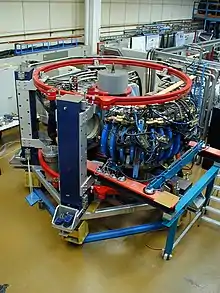 |
| Wendelstein 7-A | Shut down | ? | 1975-1985 | Classical stellarator | Garching | Max-Planck-Institut für Plasmaphysik | 2 m/0.1 m | 3.5 T | First "pure" stellarator without plasma current | |
| Heliotron-E | Shut down | ? | 1980-? | Heliotron | 2.2 m/0.2 m | 1.9 T | ||||
| Heliotron-DR | Shut down | ? | 1981-? | Heliotron | 0.9 m/0.07 m | 0.6 T | ||||
| Uragan-3 (M)[42] | Operational | ? | 1982-?[43] | Torsatron | Kharkiv | National Science Center, Kharkiv Institute of Physics and Technology (NSC KIPT) | 1.0 m/0.12 m | 1.3 T | ? | |
| Auburn Torsatron (AT) | Shut down | ? | 1984-1990 | Torsatron | Auburn | Auburn University | 0.58 m/0.14 m | 0.2 T | 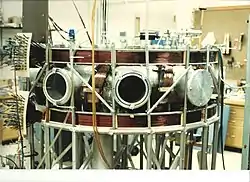 | |
| Wendelstein 7-AS | Shut down | 1982-1988 | 1988-2002 | Modular, advanced stellarator | Garching | Max-Planck-Institut für Plasmaphysik | 2 m/0.13 m | 2.6 T | First H-mode in a stellarator in 1992 | 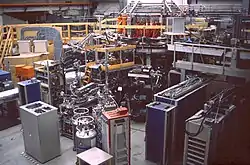 |
| Advanced Toroidal Facility (ATF) | Shut down | 1984-1988[44] | 1988-? | Torsatron | Oak Ridge | Oak Ridge National Laboratory | 2.1 m/0.27 m | 2.0 T | High-beta operation | |
| Compact Helical System (CHS) | Shut down | ? | 1989-? | Heliotron | Toki | National Institute for Fusion Science | 1 m/0.2 m | 1.5 T | ||
| Compact Auburn Torsatron (CAT) | Shut down | ?-1990 | 1990-2000 | Torsatron | Auburn | Auburn University | 0.53 m/0.11 m | 0.1 T | Study magnetic flux surfaces | 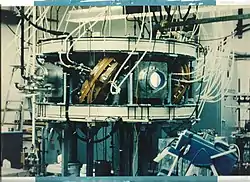 |
| H-1NF[45] | Operational | 1992- | Heliac | Canberra | Research School of Physical Sciences and Engineering, Australian National University | 1.0 m/0.19 m | 0.5 T | 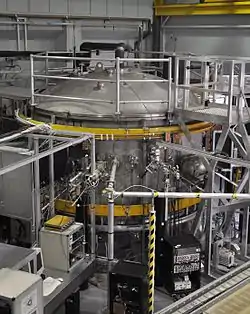 | ||
| TJ-K[46] | Operational | TJ-IU | 1994- | Torsatron | Kiel, Stuttgart | University of Stuttgart | 0.60 m/0.10 m | 0.5 T | Teaching | |
| TJ-II[47] | Operational | 1991- | 1997- | flexible Heliac | Madrid | National Fusion Laboratory, Centro de Investigaciones Energéticas, Medioambientales y Tecnológicas | 1.5 m/0.28 m | 1.2 T | Study plasma in flexible configuration | 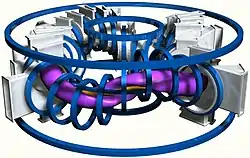 |
| LHD (Large Helical Device)[48] | Operational | 1990-1998 | 1998- | Heliotron | Toki | National Institute for Fusion Science | 3.5 m/0.6 m | 3 T | Determine feasibility of a stellarator fusion reactor | 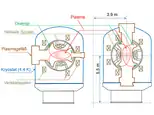 |
| HSX (Helically Symmetric Experiment) | Operational | 1999- | Modular, quasi-helically symmetric | Madison | University of Wisconsin–Madison | 1.2 m/0.15 m | 1 T | Investigate plasma transport |  | |
| Heliotron J (Heliotron J)[49] | Operational | 2000- | Heliotron | Kyoto | Institute of Advanced Energy | 1.2 m/0.1 m | 1.5 T | Study helical-axis heliotron configuration | ||
| Columbia Non-neutral Torus (CNT) | Operational | ? | 2004- | Circular interlocked coils | New York City | Columbia University | 0.3 m/0.1 m | 0.2 T | Study of non-neutral plasmas | |
| Uragan-2(M)[50] | Operational | 1988-2006 | 2006-[51] | Heliotron, Torsatron | Kharkiv | National Science Center, Kharkiv Institute of Physics and Technology (NSC KIPT) | 1.7 m/0.24 m | 2.4 T | ? | |
| Quasi-poloidal stellarator (QPS)[52][53] | Cancelled | 2001-2007 | - | Modular | Oak Ridge | Oak Ridge National Laboratory | 0.9 m/0.33 m | 1.0 T | Stellarator research | 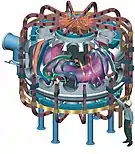 |
| NCSX (National Compact Stellarator Experiment) | Cancelled | 2004-2008 | - | Helias | Princeton | Princeton Plasma Physics Laboratory | 1.4 m/0.32 m | 1.7 T | High-β stability | 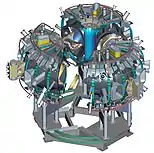 |
| Compact Toroidal Hybrid (CTH) | Operational | ? | 2007?- | Torsatron | Auburn | Auburn University | 0.75 m/0.2 m | 0.7 T | Hybrid stellarator/tokamak | 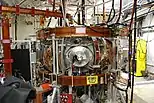 |
| HIDRA (Hybrid Illinois Device for Research and Applications)[54] | Operational | 2013-2014 (WEGA) | 2014- | ? | Urbana, IL | University of Illinois | 0.72 m/0.19 m | 0.5 T | Stellarator and tokamak in one device | 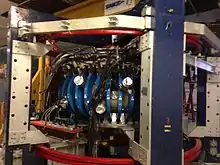 |
| UST_2[55] | Operational | 2013 | 2014- | modular three period quasi-isodynamic | Madrid | Charles III University of Madrid | 0.29 m/0.04 m | 0.089 T | 3D-printed stellarator | 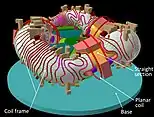 |
| Wendelstein 7-X[56] | Operational | 1996-2015 | 2015- | Helias | Greifswald | Max-Planck-Institut für Plasmaphysik | 5.5 m/0.53 m | 3 T | Steady-state plasma in fully optimized stellarator | 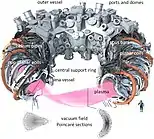 |
| SCR-1 (Stellarator of Costa Rica) | Operational | 2011-2015 | 2016- | Modular | Cartago | Instituto Tecnológico de Costa Rica | 0.14 m/0.042 m | 0.044 T | 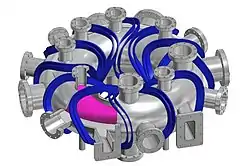 |
Magnetic mirror
- Baseball I/Baseball II Lawrence Livermore National Laboratory, Livermore CA.
- TMX, TMX-U Lawrence Livermore National Laboratory, Livermore CA.
- MFTF Lawrence Livermore National Laboratory, Livermore CA.
- Gas Dynamic Trap at Budker Institute of Nuclear Physics, Akademgorodok, Russia.
Toroidal Z-pinch
- Perhapsatron (1953, USA)
- ZETA (Zero Energy Thermonuclear Assembly) (1957, United Kingdom)
Reversed field pinch (RFP)
- ETA-BETA II in Padua, Italy (1979-1989)
- RFX (Reversed-Field eXperiment), Consorzio RFX, Padova, Italy[57]
- MST (Madison Symmetric Torus), University of Wisconsin–Madison, United States[58]
- T2R, Royal Institute of Technology, Stockholm, Sweden
- TPE-RX, AIST, Tsukuba, Japan
- KTX (Keda Torus eXperiment) in China (since 2015)[59]
Field-Reversed Configuration (FRC)
- C-2 Tri Alpha Energy
- C-2U Tri Alpha Energy
- C-2W TAE Technologies
- LSX University of Washington
- IPA University of Washington
- HF University of Washington
- IPA- HF University of Washington
Plasma pinch
- Trisops - 2 facing theta-pinch guns
Levitated Dipole
- Levitated Dipole Experiment (LDX), MIT/Columbia University, United States[60]
Inertial confinement
Solid state lasers
- National Ignition Facility (NIF) at LLNL in California, US[61]
- Laser Mégajoule of the Commissariat à l'Énergie Atomique in Bordeaux, France (under construction)[62]
- OMEGA EL Laser at the Laboratory for Laser Energetics, Rochester, US
- Gekko XII at the Institute for Laser Engineering in Osaka, Japan
- ISKRA-4 and ISKRA-5 Lasers at the Russian Federal Nuclear Center VNIIEF[63]
- Pharos laser, 2 beam 1 kJ/pulse (IR) Nd:Glass laser at the Naval Research Laboratories
- Vulcan laser at the central Laser Facility, Rutherford Appleton Laboratory, 2.6 kJ/pulse (IR) Nd:glass laser
- Trident laser, at LANL; 3 beams total; 2 x 400 J beams, 100 ps – 1 us; 1 beam ~100 J, 600 fs – 2 ns.
Gas lasers
- NIKE laser at the Naval Research Laboratories, Krypton Fluoride gas laser
- PALS, formerly the "Asterix IV", at the Academy of Sciences of the Czech Republic,[64] 1 kJ max. output iodine laser at 1.315 micrometre fundamental wavelength
Solid-state lasers
- 4 pi laser built during the mid 1960s at Lawrence Livermore National Laboratory
- Long path laser built at LLNL in 1972
- The two beam Janus laser built at LLNL in 1975
- The two beam Cyclops laser built at LLNL in 1975
- The two beam Argus laser built at LLNL in 1976
- The 20 beam Shiva laser built at LLNL in 1977
- 24 beam OMEGA laser completed in 1980 at the University of Rochester's Laboratory for Laser Energetics
- The 10 beam Nova laser (dismantled) at LLNL. (First shot taken, December 1984 – final shot taken and dismantled in 1999)
Gas lasers
- "Single Beam System" or simply "67" after the building number it was housed in, a 1 kJ carbon dioxide laser at Los Alamos National Laboratory
- Gemini laser, 2 beams, 2.5 kJ carbon dioxide laser at LANL
- Helios laser, 8 beam, ~10 kJ carbon dioxide laser at LANL — Media at Wikimedia Commons
- Antares laser at LANL. (40 kJ CO2 laser, largest ever built, production of hot electrons in target plasma due to long wavelength of laser resulted in poor laser/plasma energy coupling)
- Aurora laser 96 beam 1.3 kJ total krypton fluoride (KrF) laser at LANL
- Sprite laser few joules/pulse laser at the Central Laser Facility, Rutherford Appleton Laboratory
Z-Pinch
- Z Pulsed Power Facility
- ZEBRA device at the University of Nevada's Nevada Terawatt Facility[65]
- Saturn accelerator at Sandia National Laboratory[66]
- MAGPIE at Imperial College London
- COBRA at Cornell University
- PULSOTRON[67]
Magnetized target fusion
- FRX-L
- FRCHX
- General Fusion - under development
- LINUS project
References
- "International tokamak research".
- ASDEX at the Max Planck Institute for Plasma Physics
- "Forschungszentrum Jülich - Plasmaphysik (IEK-4)". fz-juelich.de (in German).
- Progress in Fusion Research - 30 Years of TEXTOR
- "Tokamak Fusion Test Reactor". 2011-04-26. Archived from the original on 2011-04-26.
- "EFDA-JET, the world's largest nuclear fusion research experiment". 2006-04-30. Archived from the original on 2006-04-30.
- ":::. Instituto Nacional de Investigaciones Nucleares | Fusión nuclear ". 2009-11-25. Archived from the original on 2009-11-25.
- "All-the-Worlds-Tokamaks". tokamak.info.
- Yoshikawa, M. (2006-10-02). "JT-60 Project". Fusion Technology 1978. 2: 1079. Bibcode:1979fute.conf.1079Y. Archived from the original on 2006-10-02.
- "diii-d:home [MFE: DIII-D and Theory]". fusion.gat.com. Retrieved 2018-09-04.
- "DIII-D National Fusion Facility (DIII-D) | U.S. DOE Office of Science (SC)". science.energy.gov. Retrieved 2018-09-04.
- "U of S". 2011-07-06. Archived from the original on 2011-07-06.
- "Tore Supra". www-fusion-magnetique.cea.fr. Retrieved 2018-09-04.
- . 2014-05-12 https://web.archive.org/web/20140512214251/http://www.ipp.cas.cz/Tokamak/index?m=comp. Archived from the original on 2014-05-12. Missing or empty
|title=(help) - "COMPASS - General information". 2013-10-25. Archived from the original on 2013-10-25.
- . 2006-04-24 https://web.archive.org/web/20060424061102/http://www.fusion.org.uk/culham/start.htm. Archived from the original on 2006-04-24. Missing or empty
|title=(help) - "MIT Plasma Science & Fusion Center: research>alcator>". 2015-07-09. Archived from the original on 2015-07-09.
- "Centro de Fusão Nuclear". cfn.ist.utl.pt. Archived from the original on 2010-03-07. Retrieved 2012-02-13.
- "EPFL". crppwww.epfl.ch.
- "Pegasus Toroidal Experiment". pegasus.ep.wisc.edu.
- "NSTX-U". nstx-u.pppl.gov. Retrieved 2018-09-04.
- "MAST - the Spherical Tokamak at UKAEA Culham". 2006-04-21. Archived from the original on 2006-04-21.
- "The SST-1 Tokamak Page". 2014-06-20. Archived from the original on 2014-06-20.
- "EAST (HT-7U Super conducting Tokamak)----Hefei Institutes of Physical Science, The Chinese Academy of Sciences". english.hf.cas.cn.
- . 2008-05-30 https://web.archive.org/web/20080530221257/http://www.nfri.re.kr/. Archived from the original on 2008-05-30. Missing or empty
|title=(help) - "Korean artificial sun sets the new world record of 20-sec-long operation at 100 million degrees". phys.org. Retrieved 2020-12-26.
- . 2013-11-10 https://web.archive.org/web/20131110043518/http://www.triam.kyushu-u.ac.jp/QUEST_HP/quest_e.html. Archived from the original on 2013-11-10. Missing or empty
|title=(help) - "ST25 » Tokamak Energy".
- "ST40 » Tokamak Energy".
- "Status and Plans on MAST-U". 2016-12-13.
- "China completes new tokamak".
- "The JT-60SA project".
- "ITER - the way to new energy". ITER.
- "The DTT Project".
- "The new Divertor Tokamak Test facility" (PDF).
- "SPARC at MIT Plasma Science and Fusion Center".
- Creely, A. J.; Greenwald, M. J.; Ballinger, S. B.; Brunner, D.; Canik, J.; Doody, J.; Fülöp, T.; Garnier, D. T.; Granetz, R.; Gray, T. K.; Holland, C. (2020). "Overview of the SPARC tokamak". Journal of Plasma Physics. 86 (5). Bibcode:2020JPlPh..86e8602C. doi:10.1017/S0022377820001257. ISSN 0022-3778.
- "Ignited plasma in Tokamaks - The IGNITOR project". frascati.enea.it. Archived from the original on 2020-04-19.
- The Russian-Italian IGNITOR Tokamak Project: Design and status of implementation (2017)
- Gao, X. (2013-12-17). "Update on CFETR Concept Design" (PDF). www-naweb.iaea.org.
- Kim, K.; Im, K.; Kim, H. C.; Oh, S.; Park, J. S.; Kwon, S.; Lee, Y. S.; Yeom, J. H.; Lee, C. (2015). "Design concept of K-DEMO for near-term implementation". Nuclear Fusion. 55 (5): 053027. Bibcode:2015NucFu..55e3027K. doi:10.1088/0029-5515/55/5/053027. ISSN 0029-5515.
- "History | ННЦ ХФТИ". kipt.kharkov.ua.
- https://ipp.kipt.kharkov.ua/u3m/u3m_eng.html
- https://www.ornl.gov/content/ornl-review-v17n3
- Department, Head of; prl@physics.anu.edu.au. "Plasma Research Laboratory - PRL - ANU". prl.anu.edu.au.
- "TJ-K - FusionWiki". fusionwiki.ciemat.es.
- CIEMAT. "Centro de Investigaciones Energéticas, Medioambientales y Tecnológicas". ciemat.es (in Spanish).
- "Large Helical Device Project". lhd.nifs.ac.jp. Archived from the original on 2010-04-12. Retrieved 2006-04-20.
- "Heliotron J Project". iae.kyoto-u.ac.jp/en/joint/heliotron-j.html.
- "History | ННЦ ХФТИ". kipt.kharkov.ua.
- https://ipp.kipt.kharkov.ua/u2m/u2m_en.html
- "QPS Home Page".
- http://qps.fed.ornl.gov/pvr/pdf/qpsentire.pdf
- "HIDRA – Hybrid Illinois Device for Research and Applications | CPMI - Illinois". cpmi.illinois.edu.
- UST_2 at Vying Fusion Energy
- "Wendelstein 7-X". ipp.mpg.de/w7x.
- "CONSORZIO RFX - Ricerca Formazione Innovazione". igi.cnr.it. Archived from the original on 2009-09-01. Retrieved 2018-04-16.
- Hartog, Peter Den. "MST - UW Plasma Physics". plasma.physics.wisc.edu.
- Liu, Wandong; et, al. (2017). "Overview of Keda Torus eXperiment initial results". Nuclear Fusion. 57 (11): 116038. Bibcode:2017NucFu..57k6038L. doi:10.1088/1741-4326/aa7f21. ISSN 0029-5515.
- "Levitated Dipole Experiment". 2004-08-23. Archived from the original on 2004-08-23.
- "Lasers, Photonics, and Fusion Science: Science and Technology on a Mission". llnl.gov.
- "CEA - Laser Mégajoule". www-lmj.cea.fr.
- "RFNC-VNIIEF - Science - Laser physics". 2005-04-06. Archived from the original on 2005-04-06.
- "PALS, Laser". archive.is. 2001-06-27. Archived from the original on 2001-06-27.
- "University of Nevada, Reno. Nevada Terawatt Facility". archive.is. 2000-09-19. Archived from the original on 2000-09-19.
- "Sandia National Laboratories: National Security Programs". sandia.gov.
- "PULSOTRON". pulsotron.org. Archived from the original on 2019-04-01. Retrieved 2020-03-09.